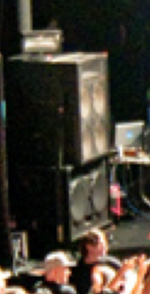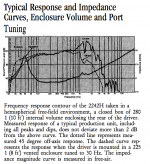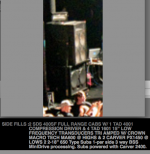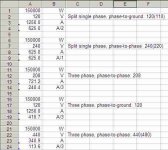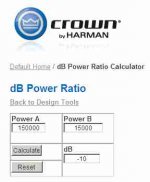An externally hosted image should be here but it was not working when we last tested it.
^^^ This looks like a good start
This is from 'Transmission' in Slovakia. Twenty eight horn loaded 21" drivers* :O
I was googling around and it looks like Eva Longoria's restaurant in Vegas is using four of these.
* Funktion-One | Products | F221
such a huge box.... such a short horn. they claim response down to 20, but its only 40 hz in the +/-3 db spec, AND the box handles 1500 watts AES.... wat. A pair of othorn is similarly sized (a tiny bit bigger) and will handle almost 4000w aes, and go down to 30.
Yeah the JBL I posted earlier used a single 18" versus dual 21s, and is a bigger cabinet!
Patrick,Here's a pic of their subs: four eighteens in a vented box. Their subs are the boxes facing inward, that measure about 4' x 4' with four eighteens and a slot vent across the top.
The only cabinets I see facing inward in the photo you posted is a two box side fill, top box appears to be a 4x12" with HF horn over what looks like a 2 x15" ported cabinet using round ports.
Where did you get the idea that Cal Perkins would design 18" subs using 35 Hz Fs JBL speakers with a 65Hz cutoff?
Art
Attachments
Patrick,
The only cabinets I see facing inward in the photo you posted is a two box side fill, top box appears to be a 4x12" with HF horn over what looks like a 2 x15" ported cabinet using round ports.
Where did you get the idea that Cal Perkins would design 18" subs using 35 Hz Fs JBL speakers with a 65Hz cutoff?
Art
The 65hz figure is off the spec page at Parts Express: JBL 2242H 18" Maximum Output LF Driver 8 Ohm | 294-485
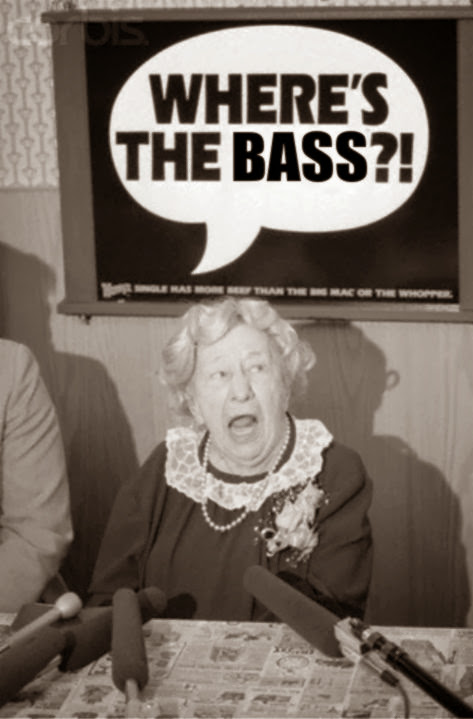
The reason I believe that the subs at The Roseland can't dig deep is based on a combination of going to shows there myself, and hearing everyone bitch about the shitty sound there. Just read the Yelp page, it's review after review of people whining about the sound. Here's a couple:
- "The sound quality there is brutal -- terrible sound and painfully loud. I've been to plenty of shows at different venues across the country so have a good basis for comparison.
I would not recommend this venue to anyone unless your under 21, and/or don't care about how music sounds . . . I will not be going back no matter who is playing, I would rather drive to Seattle." - "Horrible. This place is just plain terrible. I went to see Purity Ring here last night after it got moved from the Wonder. I would never come here to see any show unless my already purchased tickets were moved here and I had no choice. The sound quality is just plain brutal"
- "I don't know if I can fairly review this place. I've had a great time here and I've had a terrible time here. Most of the time though, it's oversold and packed, and the sound sucks."
Roseland reminds me of a lot of clubs in 2014. Basically the sound system was designed using a set of criteria that worked great in 1984, but in 2014? Not so much. I'm certain that Cal Perkins is an excellent engineer, with a resume like that, he has to be. He simply designed speakers for an era that didn't include 28hz bass lines and shows with nothing but bass and treble for four hours straight. (DJs getting paid to show up to a show and press 'play' on a laptop is a recent phenomenon of course; it's really been prevalent for only six years or so. If these DJs were playing vinyl this wouldn't be an issue.)
Or to quote this article from ProSoundWeb, about this very club, "Looks like a state of the art 30 year old PA."* (You're on the thread BTW.)
*ever heard of "perkins spec"?
Patrick,
The only cabinets I see facing inward in the photo you posted is a two box side fill, top box appears to be a 4x12" with HF horn over what looks like a 2 x15" ported cabinet using round ports.
Where did you get the idea that Cal Perkins would design 18" subs using 35 Hz Fs JBL speakers with a 65Hz cutoff?
Art
Here's some more information on the mysterious Cal Perkins subs:
Identify this.....frontloaded JBL PA - plasma sound - High Efficiency Speaker Asylum
Hi,
recently I had the chance to get a JBL 18'woofer quartet. Then I remembered that concert I saw and heard in Portland,OR with the wonderful sound from the pictured PA.
Bad club sound has far more to do with deaf, drunk & stoned sound "engineers" than the system installed.The 65hz figure is off the spec page at Parts Express.
The reason I believe that the subs at The Roseland can't dig deep is based on a combination of going to shows there myself, and hearing everyone bitch about the shitty sound there.
I'm certain that Cal Perkins is an excellent engineer, with a resume like that, he has to be. He simply designed speakers for an era that didn't include 28hz bass lines and shows with nothing but bass and treble for four hours straight.
It takes less than 100 dB at 4 kHz (the frequency first lost with noise induced hearing loss) to sound as loud as 120 dB at 40 Hz, which means your sound experience can easily be ruined regardless of the vintage of the system.
Typically, the idiot sound person pushes the LF to the limit, which results in sloppy sounding bass, then tries to "clean it up" by ramming too much HF to compensate, often hitting the "end stops" (hard limiting) that protect mid/hf drivers, but don't protect hearing abuse.
Any one of the dozens of mid /high horn drivers in an average large club can easily get loud enough to make anyone not already deaf a step closer.
No matter how much LF a system has, it only takes a push of a fader to make the HF unbearable.
As to the Parts Express suggestion that an "optimum" size for the 2242 is 2.52 cubic feet (resulting in a 65 Hz F3), Cal Perkins would just laugh.
His Roseland sub cabinets are probably a lot closer to 6-8 cubic feet and a 35-40 Hz tuning, and would be flatter (but not go quite as low) as JBL's chart for typical enclosure volume and tuning below.
Art
P.S. I was mistaken about the Roseland side fills, they are a HF horn with 4 x15" above a 2x18" similar to the Meyers 650.
That club sure has a lot of expensive HF drivers!
Attachments
Last edited:
Well, I think I solved the whole mystery of "why does PK sound completely different than 95% of the PAs out there?"
Here's the short explanation:
EDM and dubstep frequently have basslines with ZERO harmonics. Due to the lack of harmonics, it's possible to have very very very loud low frequency effects, and it doesn't sound muddy. This would NOT work with conventional instruments. For instance, if you had a rock track with a 35hz drum and a 2nd harmonic at 70hz, that track would sound 'muddy' if the fundamental was twenty decibels louder than the rest of the track.
But in EDM? It works. By stripping out the harmonics it allows you to crank up the very low frequencies to absurd levels, due to the fact that we're not sensitive to low frequencies.
BUT - and this is a big BUT - this trick only works if your subs are able to play very low frequencies, and play them with low distortion.
If you try the same trick with a vented sub that has a cutoff of 50hz, you'll probably destroy the subwoofer. This little problem might encourage sound engineers to use aggressive high pass filters, which actually compounds the problem. (But it keeps the subs from blowing up.)
I have to hand it to Sine143 - he gave me the clue that helped explain what the difference is. In his post, he stated that there weren't any 28hz basslines in brostep.
So I did a spectral analysis.
Before I get to that, let's start with a couple of tracks from the 70s and 80s:

Here's the drum kick on 'Goodbye Stranger' by Supertramp. In a post on another thread, Art mentioned that the drum from some Supertramp tracks was enough to loosen the plaster. In this snippet, I see a lot of energy in the octave from 50 to 100hz.

Here's an analysis of what may be the most famous club track of the last thirty years, "Blue Monday" by New Order. This track digs deep - all the way down to 30hz. I remember the first time I heard this in a club, the walls would shake with bass. The bass line is synthesized, and this technology was so new, the band actually had to build the instruments from a kit. Needless to say, this is one famous tune.

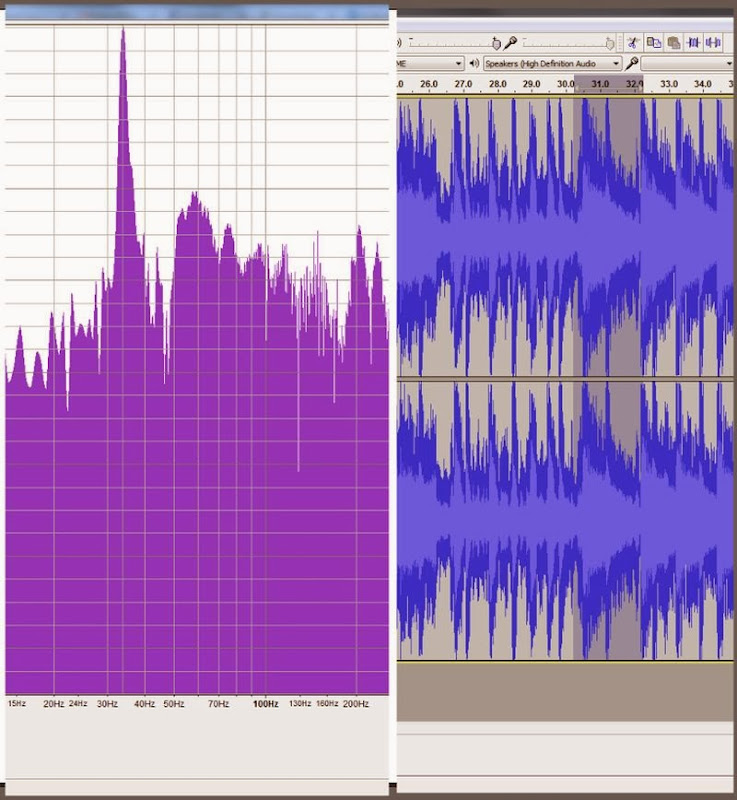
Aaaaand here's The Money Shot. "Here We Go" by Bassnectar.
In the spectral analysis of the three tracks, you'll notice a couple of things about the Bassnectar track. First, there's virtually no harmonics. The bassline is practically a sinewave, centered at 35hz. Second, the bassline is practically engineered to blow up vented subs. It's TWENTY ONE DECIBELS louder than the rest of the track.
I think that one graph basically sums up why the PK systems sound 'different.' If that Bassnectar track was played on a vented box with an F3 of 50hz, the 35hz fundamental would likely blow up the speaker. A bassline that's 21dB louder than the rest of the tune is a real speaker killer.
The key is the lack of harmonics in the dubstep track.
If we look at the Fletcher Munson curves, a sound that's 110dB at 30hz will sound as loud as a sound that's 100dB at 60hz.
The Bassnectar track is taking advantage of this. If the bassline at 35hz had harmonics at 70hz and 140hz, the whole song would sound muddy and slow.
But the lack of harmonics means that you can have this monster bassline at a very low frequency, and it doesn't make the rest of the spectrum sound 'muddy.'
TLDR : Bassnectar's music would sound incredibly muddy if it had harmonics, but it's made on a computer, so it doesn't.
I think the spectral analysis of the tracks explains why 90% of the venues that I go to just can't reproduce EDM and dubstep properly, even though they sound perfectly acceptable with rock bands. It's the low frequency basslines with zero harmonics that are to blame.
Here's the short explanation:
EDM and dubstep frequently have basslines with ZERO harmonics. Due to the lack of harmonics, it's possible to have very very very loud low frequency effects, and it doesn't sound muddy. This would NOT work with conventional instruments. For instance, if you had a rock track with a 35hz drum and a 2nd harmonic at 70hz, that track would sound 'muddy' if the fundamental was twenty decibels louder than the rest of the track.
But in EDM? It works. By stripping out the harmonics it allows you to crank up the very low frequencies to absurd levels, due to the fact that we're not sensitive to low frequencies.
BUT - and this is a big BUT - this trick only works if your subs are able to play very low frequencies, and play them with low distortion.
If you try the same trick with a vented sub that has a cutoff of 50hz, you'll probably destroy the subwoofer. This little problem might encourage sound engineers to use aggressive high pass filters, which actually compounds the problem. (But it keeps the subs from blowing up.)
I have to hand it to Sine143 - he gave me the clue that helped explain what the difference is. In his post, he stated that there weren't any 28hz basslines in brostep.
So I did a spectral analysis.
Before I get to that, let's start with a couple of tracks from the 70s and 80s:
An externally hosted image should be here but it was not working when we last tested it.

Here's the drum kick on 'Goodbye Stranger' by Supertramp. In a post on another thread, Art mentioned that the drum from some Supertramp tracks was enough to loosen the plaster. In this snippet, I see a lot of energy in the octave from 50 to 100hz.
An externally hosted image should be here but it was not working when we last tested it.

Here's an analysis of what may be the most famous club track of the last thirty years, "Blue Monday" by New Order. This track digs deep - all the way down to 30hz. I remember the first time I heard this in a club, the walls would shake with bass. The bass line is synthesized, and this technology was so new, the band actually had to build the instruments from a kit. Needless to say, this is one famous tune.


Aaaaand here's The Money Shot. "Here We Go" by Bassnectar.
In the spectral analysis of the three tracks, you'll notice a couple of things about the Bassnectar track. First, there's virtually no harmonics. The bassline is practically a sinewave, centered at 35hz. Second, the bassline is practically engineered to blow up vented subs. It's TWENTY ONE DECIBELS louder than the rest of the track.
I think that one graph basically sums up why the PK systems sound 'different.' If that Bassnectar track was played on a vented box with an F3 of 50hz, the 35hz fundamental would likely blow up the speaker. A bassline that's 21dB louder than the rest of the tune is a real speaker killer.
An externally hosted image should be here but it was not working when we last tested it.
The key is the lack of harmonics in the dubstep track.
If we look at the Fletcher Munson curves, a sound that's 110dB at 30hz will sound as loud as a sound that's 100dB at 60hz.
The Bassnectar track is taking advantage of this. If the bassline at 35hz had harmonics at 70hz and 140hz, the whole song would sound muddy and slow.
But the lack of harmonics means that you can have this monster bassline at a very low frequency, and it doesn't make the rest of the spectrum sound 'muddy.'
TLDR : Bassnectar's music would sound incredibly muddy if it had harmonics, but it's made on a computer, so it doesn't.
I think the spectral analysis of the tracks explains why 90% of the venues that I go to just can't reproduce EDM and dubstep properly, even though they sound perfectly acceptable with rock bands. It's the low frequency basslines with zero harmonics that are to blame.
show the average of the whole track post intro (for bassnectar). this will give you a better idea of 35hz vs the rest of the bass.
Bassnectar is one of the few exceptions to the brostep rule, but with his 15 plus year pedigree in producing, he has a leg up on 99/100 brostep producers out there (plus he's been touring with big soundsystems, PK specifically, for almost 10 years now, longer than skrillex has know what edm was)0
Bassnectar is one of the few exceptions to the brostep rule, but with his 15 plus year pedigree in producing, he has a leg up on 99/100 brostep producers out there (plus he's been touring with big soundsystems, PK specifically, for almost 10 years now, longer than skrillex has know what edm was)0
Last edited:
and to say that bass music would sound muddy if it had harmonics is false.
one of my favorite tracks at the moment, Space Cash by commodo. Not only does it go low (28hz), but it features a fairly saturated bassline. Honestly on a decent soundsystem, this tune sounds like no other. bassline is ALIVE
Commodo - $pace Cash - YouTube
one of my favorite tracks at the moment, Space Cash by commodo. Not only does it go low (28hz), but it features a fairly saturated bassline. Honestly on a decent soundsystem, this tune sounds like no other. bassline is ALIVE
Commodo - $pace Cash - YouTube
and to say that bass music would sound muddy if it had harmonics is false.
one of my favorite tracks at the moment, Space Cash by commodo. Not only does it go low (28hz), but it features a fairly saturated bassline. Honestly on a decent soundsystem, this tune sounds like no other. bassline is ALIVE
Commodo - $pace Cash - YouTube
Basically I was trying to explain my perception of PK Sound systems.
Which is that they have crushing amounts of bass, but they don't make your ears bleed.
I believe this is due to a combination of both the system's ability to play low and loud, but *also* due to the content of the music that's being played on them.

For instance, this two second snipped of 'Here we Go' by Bassnectar has a bassnote at 35hz that's over 20dB louder than the content at 70hz.

If you played this Supertramp track at the same maximum SPL, it would sound a lot louder, because the bass, midbass, and midrange are all withing a few decibels of each other.
So that explains the peculiar combination of crushing bass, but without the painful midrange and treble that I hear at most shows.
The trick with the harmonics is the Fletcher Munson curves. For instance, if the Bassnectar track had a second harmonic at 70hz that was six dB below the fundamental the harmonic would appear more prominent than the fundamental. (Because we're much more sensitive to 70hz than to 35hz.)
But the 35hz note doesn't have a harmonic. So if played back on a system that has a fourth order rolloff at 50hz, like a vented box, the 35hz bassline would be much less prominent.
So it's not as simple as having a big amp, or a sub that plays low, or music that goes down to 35hz. It's all of the above. But some of these items are more important than others. For instance, I'd rather listen to this music on a system that can do 110dB and has an F3 at 35hz, instead of a system that can do 120dB and has an F3 at 50hz. Due to the steep rolloff of vented boxes, the second system will significantly reduce the 35hz fundamental.
"The difference between a 150,000 watt bass system and a 15,000 watt system (assuming mutual coupling of 10 times more drivers) is 20 dB.
Bringing in 10 times the sub cabinets would allow a 10 dB increase in level (twice as loud) using the same power."
The contour lines of equal loundness get further apart at higher volume, and the limit for direct radiator efficiency from coupling tops out at around 25% or so.
100A?
I used to run a small show that pulled 120A on two legs (not counting the fog machines).
Bringing in 10 times the sub cabinets would allow a 10 dB increase in level (twice as loud) using the same power."
The contour lines of equal loundness get further apart at higher volume, and the limit for direct radiator efficiency from coupling tops out at around 25% or so.
100A?
I used to run a small show that pulled 120A on two legs (not counting the fog machines).
Dennis,"The difference between a 150,000 watt bass system and a 15,000 watt system (assuming mutual coupling of 10 times more drivers) is 20 dB.
Bringing in 10 times the sub cabinets would allow a 10 dB increase in level (twice as loud) using the same power."
The contour lines of equal loundness get further apart at higher volume, and the limit for direct radiator efficiency from coupling tops out at around 25% or so.
100A?
I recognize my quote, but don't understand the question.
A 150,000 watt sub system using 95% efficient amps would draw 438.6A (amperes) peak, (or average if running content with only 3 dB crest factor) at 120 volts from each leg of a three phase system.
Art
Hi Art,
I don't know what I'm missing as this level of PA is completely out of my experience range (well, not completely - I have been known to leave the area/stadium/concert-or-studio) but 150kW to 15kW used to be -10dB (not 20dB). As you say, if you have any kind of mutual coupling you'll get more output from a 10x increase in system power than 10dB, provided you'll also increase the number of loudspeakers (otherwise: burn baby burn).
To the best of my memory there is no 3dB crest factor in the power draw, the current and the voltage are already RMS values, and you're hoping that your system has a power factor of 1.
Just for fun I ran a few of the typical U.S. power system voltages into a spreadsheet, and it looks like bringing your own 440 (480) 3-Phase generator or power line would be advisable.
In what feels like another lifetime I used to hang out with military portable generators, that would have called for something big, or for multiples. You people have all the fun.
Regards,
I don't know what I'm missing as this level of PA is completely out of my experience range (well, not completely - I have been known to leave the area/stadium/concert-or-studio) but 150kW to 15kW used to be -10dB (not 20dB). As you say, if you have any kind of mutual coupling you'll get more output from a 10x increase in system power than 10dB, provided you'll also increase the number of loudspeakers (otherwise: burn baby burn).
To the best of my memory there is no 3dB crest factor in the power draw, the current and the voltage are already RMS values, and you're hoping that your system has a power factor of 1.
Just for fun I ran a few of the typical U.S. power system voltages into a spreadsheet, and it looks like bringing your own 440 (480) 3-Phase generator or power line would be advisable.
In what feels like another lifetime I used to hang out with military portable generators, that would have called for something big, or for multiples. You people have all the fun.
Regards,
Attachments
Yes, the power difference between 150kW to 15kW is 10 dB.Hi Art,
I don't know what I'm missing as this level of PA is completely out of my experience range (well, not completely - I have been known to leave the area/stadium/concert-or-studio) but 150kW to 15kW used to be -10dB (not 20dB).
My statement said "assuming mutual coupling of 10 times more drivers", which is where the additional 10 dB comes from.
The prosound company "Clair Brothers" has some neodymium JBL woofers for sale on eBay right now. They're neat, huge displacement with the distortion reducing differential driver motor.

I made a tapped pipe for the woofer that mimics the response of the PK Sound CX800. I *think* I'll stick this in my Mazda. It's silly big, but I'm a basshead. The graph above shows the predicted response of the CX800 (grey) and my tapped pipe (black.)

Due to the higher qts on the 18Sound 18NLW9600, it's tuned higher than the JBL, which reduces displacement for the CX800.
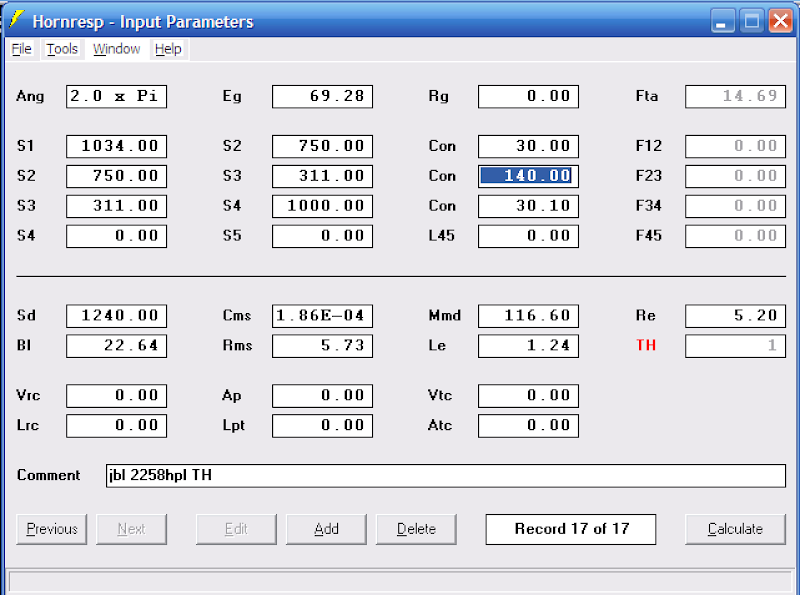
Here's my hornresp model.
All the sims are based on a single woofer; double everything to simulate *both* woofers in a CX800.
My eighteen will be here on Wednesday.
An externally hosted image should be here but it was not working when we last tested it.

I made a tapped pipe for the woofer that mimics the response of the PK Sound CX800. I *think* I'll stick this in my Mazda. It's silly big, but I'm a basshead. The graph above shows the predicted response of the CX800 (grey) and my tapped pipe (black.)

Due to the higher qts on the 18Sound 18NLW9600, it's tuned higher than the JBL, which reduces displacement for the CX800.

Here's my hornresp model.
All the sims are based on a single woofer; double everything to simulate *both* woofers in a CX800.
My eighteen will be here on Wednesday.
Last edited:
- Status
- This old topic is closed. If you want to reopen this topic, contact a moderator using the "Report Post" button.
- Home
- Loudspeakers
- Subwoofers
- PK Sound CX800: 95% efficient??
